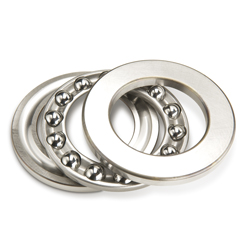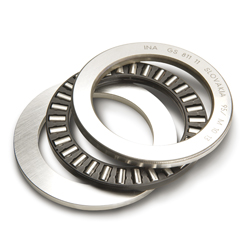Thrust Bearings
Deep groove ball thrust bearings
Constant-direction deep groove ball thrust bearings are made up of a shaft washer, a housing washer and a set of balls accommodated by a cage. The bearings do not have a self-retaining design, so the bearing components are installed separately, which is very easy to do.


Constant-direction deep groove ball thrust bearings are suitable for accommodating higher axial loads in one direction and can also support the shaft on one side, but there must be no radial loads.
Alternating-direction deep groove ball thrust bearings are made up of a shaft washer, two housing washers and two sets of balls accommodated by cages. The bearings do not have a self-retaining design, the bearing components are installed separately, which is very easy to do.
The housing washers and sets of balls are the same as in the corresponding constant-direction bearings.
The alternating-direction deep groove ball thrust bearings can accommodate axial loads in both directions and can therefore take over the guidance of the shaft on both sides as fixed bearings. However, it is not possible for them to take radial loads.
Thrust cylindrical roller bearings
Thrust cylindrical roller bearings can take very high axial loads. Despite the minimum axial space requirements, rigid, shock-resistant bearing is guaranteed. Being constant-direction, i.e. single-action bearings, they are suitable for accommodating axial loads coming from one direction. These types of bearings are primarily used where the bearing capacity of deep groove ball thrust bearings would be insufficient.
A cylindrical roller thrust bearing has a simple design and is generally made up of a shaft washer and a housing washer as well as the thrust roller and cage assembly. For this very reason, the bearing components mentioned are also available loose. The roller and cage assemblies for these thrust cylindrical roller bearings are made up of a rigid cage with the maximum number of cylindrical rollers possible. These rollers have the smallest of deviations in diameter when compared with each other and have slightly curved slope lines on the ends. These slope lines ensure that load bearing is evenly spread over the length of the rollers and they also prevent edge stress on the ends of the rollers.
Needle-thrust roller bearings
Needle-thrust roller bearings also allow for the bearing of higher axial loads as well as shock-resistant, rigid bearing. The big advantage of these bearings is the very flat design which means that there is space for bearings even with the very smallest of axes!
Unlike thrust cylindrical roller bearings, these bearings can bear still weaker axial loads, which is due to the flatter design and use of needle-thrust rollers instead of cylinder rollers, i. e a filigree design. As with thrust cylindrical roller bearings, these bearings are made up of a rigid cage which can securely guide a maximum number of needle-thrust rollers. The needle-thrust roller and cage assembly is made up of a needle-thrust roller and a cage. Normally, the surrounding machine components are not suitable for use as tracks themselves. Therefore, polished bearing washers with the appropriate hardness are available for each needle-thrust roller and cage assembly, which - combined with the needle-thrust rollers - allow for optimal, economical bearing solutions. Because of the multiple combination possibilities, bearing components are exclusively sold individually.
Spherical Roller Thrust Bearings
In the case of spherical roller thrust bearings, loads are diagonally transmitted from a track to the bearing axis. Unlike the other thrust bearings, these bearings can bear radial loads with simultaneous axial loads. The ability to bear the highest axial loads with relatively high rotational speeds is an important characteristic of this versatile type of bearing. As with the self-aligning roller bearing, this bearing design, which allows for angular movement, can compensate for the bending of the shaft and misalignment between the shaft and the housing. What is typical of this design is a high level of robustness and it is consequently often used in huge-dimension applications, e.g. swing bridges.
Spherical roller thrust bearings do not have a self-retaining design, therefore, the shaft washer with the rollers and the housing washer are installed separately.
Investigation of Rolling Bearing Defects
We are your reliable and neutral consultants for the most diverse maintenance tasks including investigation roller bearing defects.
Partner for maintenance
Our qualified service technicians will assist you to elaborate concepts which reduce the occurrence of unplanned stoppages and increase the efficiency of the installation.
Our services include training seminars on the identification and choice of products as well as seminars on assembly and dismantling and the care of mechanical spare parts.